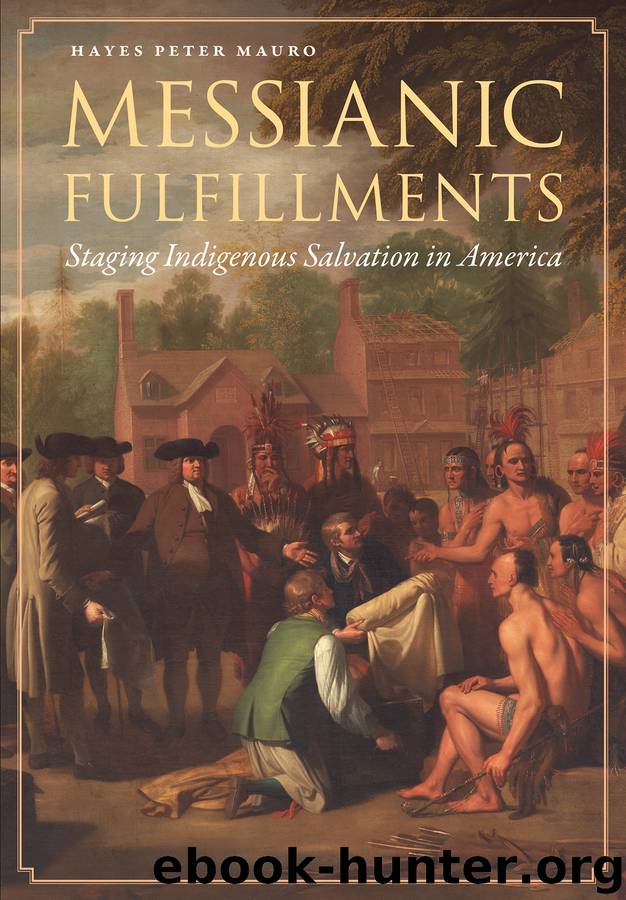Messianic Fulfillments by Mauro Hayes Peter;

Author:Mauro, Hayes Peter;
Language: eng
Format: epub
Tags: SOC021000 Social Science / Ethnic Studies / Native American Studies, REL015000 Religion / Christianity / History, HIS036040 History / United States / 19th Century
Publisher: UNP - Nebraska
The next vision occurred in 1823 and consisted of Smith being visited by the spirit, in angelic form, of the ancient prophet and historian Moroni. As mentioned previously, the Book of Mormon credits Moroni with the abridging and editing of the prophetic writings of several earlier prophets, including those of his father, Mormon, whose written commentary is contained within the book itself and after whom the book is named. During this vision, which Smith claimed happened in his bedroom one night, Moroni charged him with being God’s modern prophet. He informed Smith that the first step in his role as prophet would be unearthing two golden plates on which he had inscribed all the earlier prophetic writings. Moroni had buried the plates—conveniently—on a hillside outside of the town of Manchester, New York, where Smith and his family were currently residing.25
After prophesying about the coming apocalypse and the subsequent dawning of a new millennium, quoting various biblical verses, Moroni then instructed Smith that he should not retrieve the plates for a period of four years and then should not show them to anyone who was not authorized to see them. Smith was instructed to go to the hill each subsequent year on the same date as his initial vision until Moroni allowed him to take the plates out of the spot in which they were buried. In 1827 Smith writes that he was finally allowed to remove the plates by Moroni, who was present for each annual pilgrimage.26
C. C. A. Christensen’s series of paintings addressing the life of Joseph Smith is called the “Mormon Panorama,” considered crucial documents regarding the Church’s early history. The revelation of the golden plates by the angel Moroni is depicted in figure 25. Like many subsequent artists employed by LDS, Christensen was professionally trained. He studied at the Royal Academy of Art in Copenhagen in the 1840s and 1850s, where he converted to Mormonism. He subsequently painted only for the Church and translated the Book of Mormon into Danish. He was also employed as a missionary and traveled throughout Scandinavia in the second half of the nineteenth century in the service of Mormon evangelism. He eventually emigrated to the United States in 1857 and settled in Utah to live among his spiritual brethren; there he became a historian of Mormonism, specifically of his own evangelical activities in Scandinavia.27
In figure 25, The Hill Cumorah, Christensen has painted the critical meeting of Smith and Moroni on the hillside in 1827. This image, which may be seen as the founding revelation of the Mormon movement, corresponds to the event described in the Book of Mormon as well as in Smith’s Pearl of Great Price. Christensen, as he characteristically does, paints the scene in a manner clearly influenced by the romantic movement of the early nineteenth century, which was quite popular in northern European countries. Smith kneels in awe before Moroni, who is depicted in Christological fashion, defined by his glowing brightness, which dramatically illuminates the densely forested nighttime landscape.
Download
This site does not store any files on its server. We only index and link to content provided by other sites. Please contact the content providers to delete copyright contents if any and email us, we'll remove relevant links or contents immediately.
| African-American Studies | Asian American Studies |
| Disabled | Ethnic Studies |
| Hispanic American Studies | LGBT |
| Minority Studies | Native American Studies |
Cecilia; Or, Memoirs of an Heiress — Volume 1 by Fanny Burney(32434)
Cecilia; Or, Memoirs of an Heiress — Volume 2 by Fanny Burney(31869)
Cecilia; Or, Memoirs of an Heiress — Volume 3 by Fanny Burney(31852)
The Great Music City by Andrea Baker(31340)
We're Going to Need More Wine by Gabrielle Union(18967)
All the Missing Girls by Megan Miranda(15565)
Pimp by Iceberg Slim(14393)
Bombshells: Glamour Girls of a Lifetime by Sullivan Steve(13972)
Talking to Strangers by Malcolm Gladwell(13222)
Norse Mythology by Gaiman Neil(13204)
Fifty Shades Freed by E L James(13157)
For the Love of Europe by Rick Steves(12943)
Mindhunter: Inside the FBI's Elite Serial Crime Unit by John E. Douglas & Mark Olshaker(9199)
Crazy Rich Asians by Kevin Kwan(9167)
The Lost Art of Listening by Michael P. Nichols(7406)
Enlightenment Now: The Case for Reason, Science, Humanism, and Progress by Steven Pinker(7228)
The Four Agreements by Don Miguel Ruiz(6630)
Bad Blood by John Carreyrou(6552)
Weapons of Math Destruction by Cathy O'Neil(6142)
